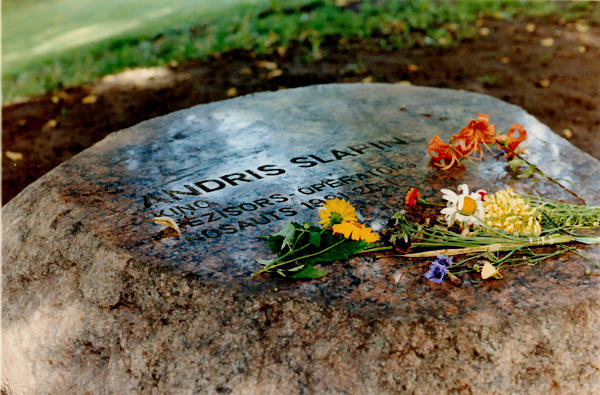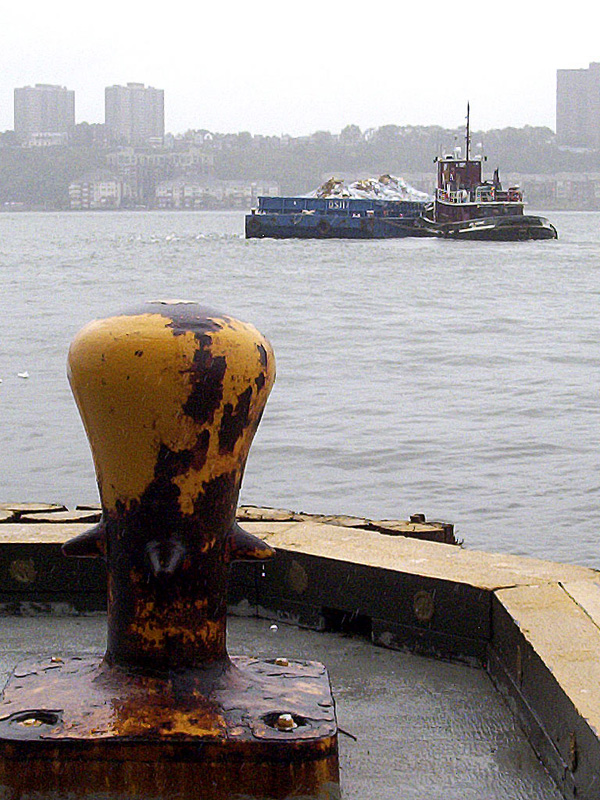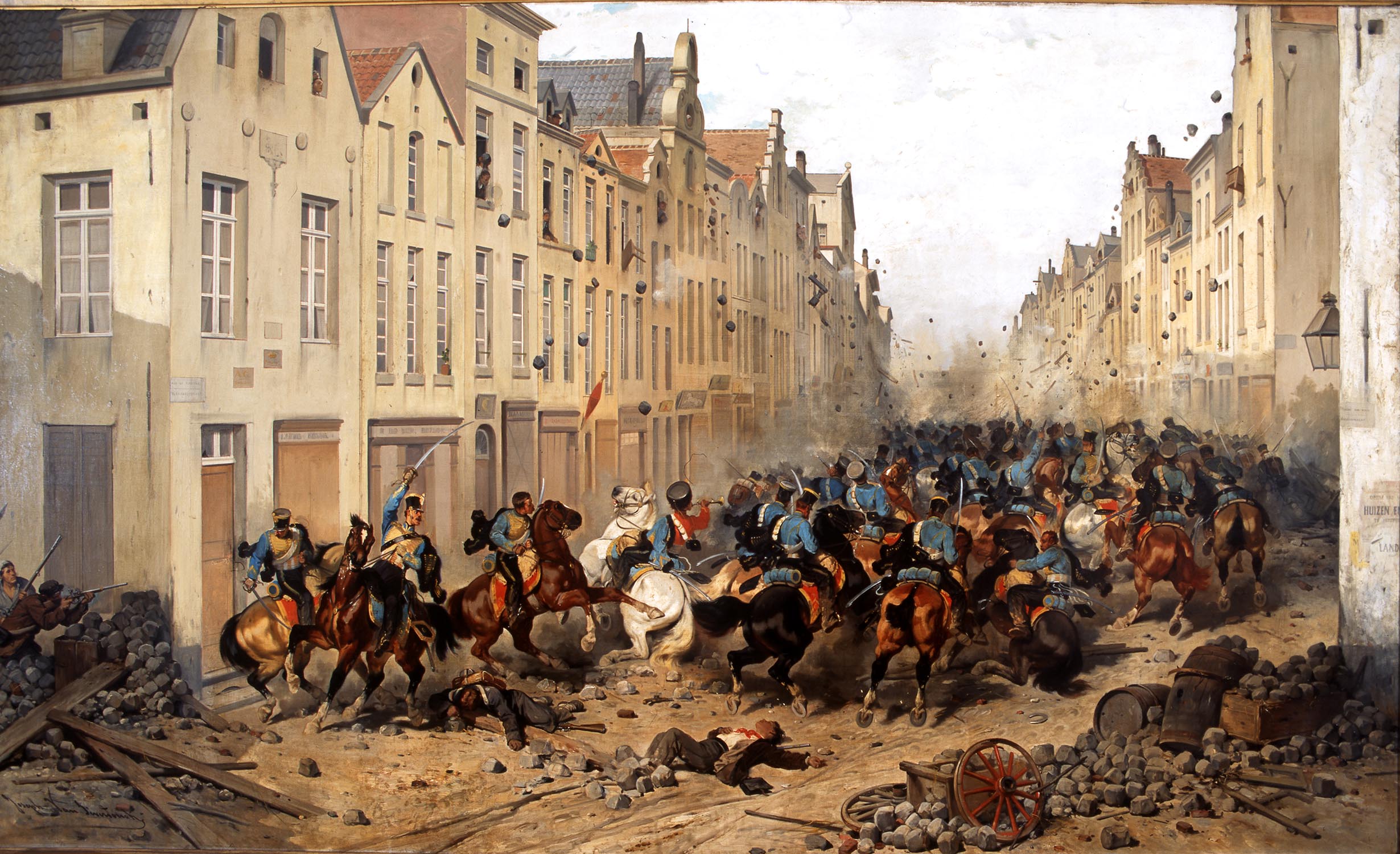|
Barricades
Barricade (from the French '' barrique'' - 'barrel') is any object or structure that creates a barrier or obstacle to control, block passage or force the flow of traffic in the desired direction. Adopted as a military term, a barricade denotes any improvised field fortification, such as on city streets during urban warfare. Barricades also include temporary traffic barricades designed with the goal of dissuading passage into a protected or hazardous area or large slabs of cement whose goal is to prevent forcible passage by a vehicle. Stripes on barricades and panel devices slope downward in the direction traffic must travel. There are also pedestrian barricades - sometimes called bike rack barricades for their resemblance to a now obsolete form of bicycle stand, or police barriers. They originated in France approximately 50 years ago and are now used around the world. They were first used in the U.S. 40 years ago by Friedrichs Mfg for New Orleans's Mardi Gras parades. ... [...More Info...] [...Related Items...] OR: [Wikipedia] [Google] [Baidu] |
The Barricades
The Barricades () were a series of confrontations between the Republic of Latvia and the Union of Soviet Socialist Republics in January 1991 which took place mainly in Riga. The events are named for the popular effort of building and protecting barricades from 13 January until about 27 January. Latvia, which had On the Restoration of Independence of the Republic of Latvia, declared restoration of independence from the Soviet Union a year earlier, anticipated that the Soviet Union might attempt to regain control over the country by force. After attacks by the Soviet OMON on Riga in early January, the government called on people to build barricades for protection of possible targets (mainly in the capital city of Riga and nearby Ulbroka, as well as Kuldīga and Liepāja). Six people were killed in further attacks, several were wounded in shootings or beaten by OMON. Most victims were shot during the Soviet attack on the Latvian Ministry of the Interior on January 20, while another ... [...More Info...] [...Related Items...] OR: [Wikipedia] [Google] [Baidu] |
Paris Commune
The Paris Commune (, ) was a French revolutionary government that seized power in Paris on 18 March 1871 and controlled parts of the city until 28 May 1871. During the Franco-Prussian War of 1870–71, the French National Guard (France), National Guard had defended Paris, and working-class radicalism grew among its soldiers. Following the establishment of the French Third Republic in September 1870 (under French chief-executive Adolphe Thiers from February 1871) and the complete defeat of the French Army by the Germans by March 1871, soldiers of the National Guard seized control of the city on 18 March. The Communards killed two French Army generals and refused to accept the authority of the Third Republic; instead, the radicals set about establishing their own independent government. The Commune governed Paris for two months, promoting policies that tended toward a Progressivism, progressive, anti-clericalism , anti-religious system, which was an eclectic mix of many 19th-cent ... [...More Info...] [...Related Items...] OR: [Wikipedia] [Google] [Baidu] |
Traffic Barricade
A traffic barricade is a type of barricade used to control the flow of traffic or block access to an area, generally for safety purposes. Traditionally made of wood, or wood and steel, many now have structural members made wholly of plastic or composite materials, and may be fitted with flashing lights. The obstruction that necessitates the use of a traffic barricade may be excavations, construction, roadblocks, debris, crime scenes, restricted areas, or other hazards. Types of barricades * The ''A-frame barricade'' or ''parade barricade'' resembles a sawhorse with a brightly painted top rail. * The ''Type I (or II) barricade'' also known as a ''waffle-board barricade'' resembles a sawhorse that can be folded flat. Type I indicates sheeting on top; Type II has sheeting on top and bottom. * The ''Type III barricade'' has multiple rails supported by two end posts. Type I, II and III barricades are commonly used for road detours and closings where vehicles are present. A-frame bar ... [...More Info...] [...Related Items...] OR: [Wikipedia] [Google] [Baidu] |
Les Misérables
''Les Misérables'' (, ) is a 19th-century French literature, French Epic (genre), epic historical fiction, historical novel by Victor Hugo, first published on 31 March 1862, that is considered one of the greatest novels of the 19th century. ''Les Misérables'' has been popularized through Adaptations of Les Misérables, numerous adaptations for film, television, and the stage, including Les Misérables (musical), a musical. In the English-speaking world, the novel is usually referred to by its original French title. However, several alternatives have been used, including ''The Miserables'', ''The Wretched'', ''The Miserable Ones'', ''The Poor Ones'', ''The Wretched Poor'', ''The Victims'', and ''The Dispossessed''. Beginning in 1815 and culminating in the 1832 June Rebellion in Paris, the novel follows the lives and interactions of several characters, particularly the struggles of ex-convict Jean Valjean and his experience of redemption. Examining the nature of law and grace, ... [...More Info...] [...Related Items...] OR: [Wikipedia] [Google] [Baidu] |
May Uprising In Dresden
The May Uprising took place in Dresden, Kingdom of Saxony in 1849; it was one of the last of the series of events known as the Revolutions of 1848. Events leading to the May Uprising In the German states, revolutions began in March 1848, starting in Berlin and spreading across the other states which now make up Germany. The heart of the revolutions was in Frankfurt, where the newly formed National Assembly, the Frankfurt Parliament, met in St Paul's Church from May 1848, calling for a constitutional monarchy to rule a new, united German nation. To form the Assembly, near-democratic elections had taken place across the German states; the majority of the members were Saxony, Saxon democrats. On 28 March 1849 the Assembly passed the first ''Reichsverfassung'' (constitution) for Germany, and in April 1849, Friedrich Wilhelm IV of Prussia was offered the crown. Despite its apparent progress, the National Assembly really depended upon the co-operation of the old leaders and Emperor; ... [...More Info...] [...Related Items...] OR: [Wikipedia] [Google] [Baidu] |
Day Of The Barricades
In the French Wars of Religion, the Day of the Barricades (in ), 12 May 1588, was an outwardly spontaneous public uprising in staunchly Catholic Paris against the moderate, hesitant, temporizing policies of Henry III. It was in fact called forth by the "Council of Sixteen" (), representing the sixteen ''quartiers'' of Paris, led by Henri, duc de Guise, head of the Catholic League, and coordinated in detail by Philip II of Spain's ambassador, Bernardino de Mendoza. Background Despite a royal interdict, the duc de Guise had returned to Paris in the wake of a betrayed conspiracy that had been set for 24 April, for he could not afford to be seen to desert his followers. In response the king, housed in the Palais du Louvre, mustered in the capital several regiments of Swiss Guards and the '' Gardes Françaises'', an act that violated a privilege of the city of Paris, not to have foreign troops quartered in the city. Rumors were spread that the heads of the Catholic party of the ... [...More Info...] [...Related Items...] OR: [Wikipedia] [Google] [Baidu] |
A Las Barricadas
"" () is a Anarchism in Spain, Spanish anarchist anthem, popularised during the Spanish Civil War as the official hymn of the Confederación Nacional del Trabajo, National Confederation of Labour (CNT). The lyrics, written by Valeriano Orobón Fernández, were based on the Polish revolutionary anthem "Whirlwinds of Danger", composed by Józef Pławiński. Since the civil war, it has gained widespread popularity among the songs of the international left and remains in use among contemporary anarchism, contemporary anarchists. Composition The lyrics to the song were composed in the early 1930s by the Spanish anarchist writer Valeriano Orobón Fernández. The Spanish lyrics were based on a German translation of the Polish revolutionary anthem "Whirlwinds of Danger" (), the lyrics of which were originally penned in the early 1880s by Wacław Święcicki and the music composed by Józef Pławiński. Popularisation By 1936, the song had become the official anthem of the Confederac ... [...More Info...] [...Related Items...] OR: [Wikipedia] [Google] [Baidu] |
June Rebellion
The June Rebellion, also called the Paris Uprising of 1832 (), was an anti-monarchist insurrection of Parisian republicans on 5 and 6 June 1832. The rebellion originated in an attempt by republicans to reverse the establishment in 1830 of the July Monarchy of , shortly after the deaths from cholera of Prime Minister and General , a popular former Army commander who became a member of the French parliament and was critical of the monarchy. The riots that followed Lamarque's funeral sparked the rebellion. This was the last outbreak of violence linked with the July Revolution of 1830. The French author memorialized the rebellion in his 1862 novel , and it figures prominently in the stage musical and films that are based on the book. Background In the 1830 July Revolution, the elected Chamber of Deputies had established a constitutional monarchy and replaced Charles X of the House of Bourbon with his more liberal cousin Louis-Philippe. This angered republicans who saw one k ... [...More Info...] [...Related Items...] OR: [Wikipedia] [Google] [Baidu] |
Bollard
A bollard is a sturdy, short, vertical post. The term originally referred to a post on a ship or quay used principally for mooring boats. In modern usage, it also refers to posts installed to control road traffic and posts designed to prevent automotive vehicles from colliding with pedestrians and structures. Etymology The term is probably related to bole, meaning a tree trunk. The earliest citation given by the ''Oxford English Dictionary'' (referring to a maritime bollard) dates from 1844, although a reference in the '' Caledonian Mercury'' in 1817 describes bollards as huge posts. History Wooden posts were used for basic traffic management from at least the second half of the 17th century. One early well-documented case is that of the "postes and rales in ye King's highway for ye (safety) of all foot passengers" erected in 1671 in the High Street of Old Brentford, Middlesex (part of the London–Bath road). Another is that of "two oak-posts" set up next to the ... [...More Info...] [...Related Items...] OR: [Wikipedia] [Google] [Baidu] |
Urban Warfare
Urban warfare is warfare in urban areas such as towns and cities. Urban combat differs from combat in the open at both Military operation, operational and the Military tactics, tactical levels. Complicating factors in urban warfare include the presence of civilians and the complexity of the urban terrain. Urban combat operations may be conducted to capitalize on strategic or tactical advantages associated with the possession or the control of a particular urban area or to deny these advantages to the enemy. It is considered to be arguably the most difficult form of warfare. Fighting in urban areas negates the advantages that one side may have over the other in armor, heavy artillery, or air support. Ambushes laid down by small groups of soldiers with handheld anti-tank weapons can destroy entire columns of modern armor (as in the Battle of Grozny (1994–95), First Battle of Grozny), while artillery and air support can be severely reduced if the "superior" party wants to limit ci ... [...More Info...] [...Related Items...] OR: [Wikipedia] [Google] [Baidu] |
Belgian Revolution
The Belgian Revolution (, ) was a conflict which led to the secession of the southern provinces (mainly the former Southern Netherlands) from the United Kingdom of the Netherlands and the establishment of an independent Kingdom of Belgium. The people of the south were mainly Flemish people, Flemings and Walloons. Both peoples were traditionally Roman Catholic as contrasted with Protestant-dominated (Dutch Reformed) people of the north. Many outspoken liberals regarded William I of the Netherlands, King William I's rule as despotic. There were high levels of unemployment and industrial unrest among the working classes. On 25 August 1830, riots erupted in Brussels and shops were looted. Theatergoers who had just watched the nationalistic opera ''La muette de Portici'' joined the mob. Uprisings followed elsewhere in the country. Factories were occupied and machinery destroyed. Order was restored briefly after William committed troops to the Southern Provinces but rioting continued ... [...More Info...] [...Related Items...] OR: [Wikipedia] [Google] [Baidu] |
Jersey Barrier
A Jersey barrier, Jersey wall, or Jersey bump is a modular concrete or plastic barrier employed to separate lanes of traffic. It is designed to minimize vehicle damage in cases of incidental contact while still preventing vehicle crossovers resulting in a likely Head-on collision#Road transport, head-on collision. Jersey barriers are also used to reroute traffic and protect pedestrians and workers during highway construction. They are named after the U.S. state of New Jersey which first started using the barriers as separators between lanes of a highway in the 1950s. The barriers are also known as a K-rail, a term stipulated in the California Department of Transportation specification for temporary concrete traffic barriers which first started using concrete median barriers in the mid-1940s. Over time, different variants were created. Taller variants, such as the Ontario Tall Wall, proved more effective at stopping vehicles and had the added advantage of blocking most oncomin ... [...More Info...] [...Related Items...] OR: [Wikipedia] [Google] [Baidu] |







